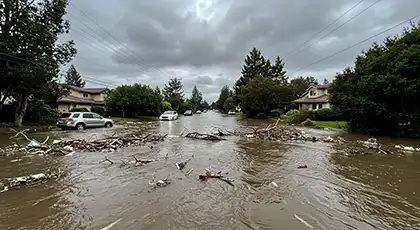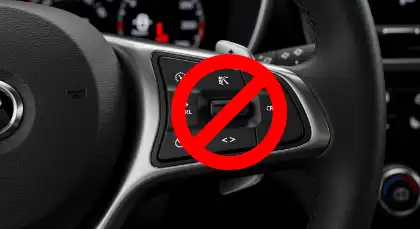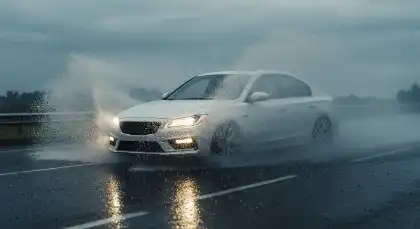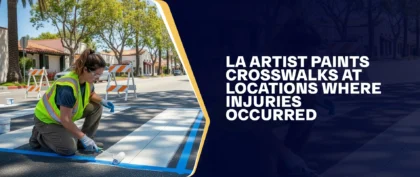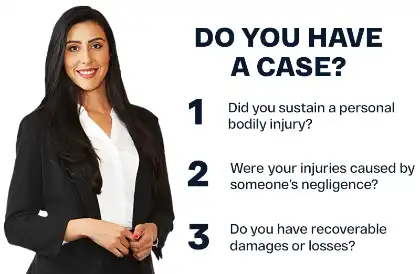Table of Contents
Is driving in the rain dangerous? The short answer is yes. Rain creates hazardous conditions that require extra caution from all drivers. It significantly affects visibility and vehicle control, substantially increasing the risk of accidents when drivers fail to adjust their habits.
What makes rainy conditions so dangerous? Wet roads significantly reduce tire traction, making vehicles more prone to skidding or hydroplaning. Heavy rain also impairs visibility, making it difficult for drivers to see road signs, other cars, and pedestrians. Additionally, accompanying high winds and sudden temperature changes can affect vehicle stability, making vehicle control difficult.
Regardless of where you live in the U.S., you will likely have to drive in the rain at some point. Understanding how rainy weather affects vehicle performance, following best safety practices, and keeping your tires and brakes in good condition can help you drive safely. However, even the most careful drivers can still be involved in accidents caused by negligent motorists or unsafe road conditions.
Arash Law is here to advocate for your rights if you’ve been injured due to someone else’s recklessness. With decades of combined experience and a commitment to our clients, our California injury attorneys are dedicated to helping injured individuals with the legal process. We handle the legal complexities so you can focus on recovery. Contact us today at (888) 488-1391 for a free, no-obligation consultation.
Why Is Driving In The Rain Dangerous?
When the rain starts to fall, road conditions change drastically, making driving more difficult. Driving in the rain can be nerve-wracking, and for good reason. It contributes to thousands of injuries and fatalities every year.
The statistics are sobering: According to the Federal Highway Administration, approximately 75% of all weather-related crashes occur on wet pavement, with nearly half happening during active rainfall. Each year in the United States, about 5,700 people lose their lives, and over 544,700 individuals suffer injuries due to wet road conditions. Specifically, more than 3,400 fatalities and over 357,300 injuries result from crashes that occur during rainfall.
Rain can make the roads slippery, leading to hydroplaning, and reduce visibility due to overcast skies. Understanding these specific risks helps drivers stay safe in rainy conditions. Knowing that the first few minutes after rain begins are particularly hazardous is crucial. During this initial period, accumulated oil and debris mixed with rainwater create an especially slippery surface, sometimes called an “oil slick,” significantly reducing traction. This is why adjusting your driving approach immediately when the rain starts is paramount for safety.
Risks Involved While Driving In The Rain
While rain can create beautiful, calming surroundings, it also significantly alters road conditions, which increases the potential for accidents. From slippery roads to limited visibility, several factors make driving in the rain more hazardous than driving on dry, clear roads.
The following sections outline the risks associated with driving in rainy conditions, providing the knowledge you need to thoroughly prepare and navigate wet roads safely.
Reduced Visibility
Driving in the rain can make it feel like the world around you is disappearing. The heavy downpour and mist can blur your vision, making it harder to see the road. When visibility is compromised, even the simplest tasks, such as spotting a stop sign or noticing a pedestrian, become more challenging.
Rain creates multiple visibility challenges that compound to make driving more dangerous:
- Rain forms a moving water layer on your windshield that windshield wipers can’t always clear effectively, creating a distorting film that obscures your view of the road ahead. This effect is particularly pronounced at night or during heavy downpours.
- Wet pavement reflects headlights and street lamps, creating glare that can temporarily blind drivers or cause eye strain over longer drives. This reflection effect can make judging distances and identifying lane markings difficult.
- Raindrops scatter light rays from your headlights, reducing their effective range. This scattering effect, also known as “backscatter,” can make the road appear darker and decrease the contrast of objects, making it harder to see clearly. This scattered light creates a wall effect that limits how far ahead you can see and makes you less visible to oncoming traffic.
- The increased humidity during rainfall often causes windshields and mirrors to fog up, further reducing visibility. Even with defrosters running, maintaining transparent glass surfaces can be challenging during rainy drives.
Research shows that drivers typically reduce speeds during rainfall, a natural response to compromised visibility. These visibility factors significantly contribute to common rain-related accidents, including rear-end collisions and pedestrian incidents. Taking specific precautions to maximize visibility becomes essential for safe driving in rainy weather.
Reduced Traction And Increased Hydroplaning Risk
When rain mixes with road contaminants like oil, dust, and rubber, it creates a slick surface. This reduces tire traction, which makes it harder to control your vehicle. As a result, the risk of motor vehicle accidents increases.
Hydroplaning happens when water builds up under your tires faster than the treads can clear it. At this point, your tires lose contact with the road and float on water. When hydroplaning begins, you lose control over steering, acceleration, and braking. The vehicle becomes nearly unresponsive until traction returns.
Several factors increase hydroplaning risk:
- Speed — The faster you drive, the more likely you are to experience hydroplaning. Risks increase significantly above 35 mph.
- Tire Tread Depth — Worn tires with less than 2/32 inch tread depth cannot effectively channel water away.
- Water Depth — Even shallow water of just 1/12 to 1/16 inch (about the height of a penny) can cause hydroplaning at highway speeds.
- Vehicle Weight — Lighter vehicles are more prone to hydroplaning than heavier ones with the same tire configuration.
Longer Stopping Distances
Wet roads dramatically increase the distance required to stop safely, which can lead to rain-related accidents. On rain-soaked pavement, stopping distances typically double compared to dry conditions.
For example, a vehicle traveling at 60 mph, which would usually stop in about 180 feet on dry pavement, requires 240-250 feet to come to a complete stop on wet roads.
The increase in stopping distance occurs because:
- Reduced tire friction means less effective braking force.
- Water between brake pads and rotors/drums temporarily reduces braking efficiency.
- Potential wheel lock-up or ABS engagement further extends stopping time.
To compensate for these factors, drivers should maintain a following distance of at least 5 to 6 seconds in the rain, which is double the 3-second rule recommended for dry conditions. This extra space provides the time needed to identify hazards and bring the vehicle to a safe stop, particularly when encountering unexpected obstacles or sudden changes in traffic.
Vehicle Malfunctions
Driving in the rain can put extra stress on your car, and sometimes, that leads to malfunctions, especially when moisture interferes with key systems. The rain can affect electrical components and other parts, causing them to malfunction or even stop functioning altogether.
The following issues highlight the risks of driving in the rain, as auto defects or malfunctions caused by moisture can quickly escalate into more significant safety hazards.
- Rain can interfere with critical vehicle systems like headlights and windshield wipers, which you rely on most during wet weather. Moisture can cause electrical shorts or mechanical issues that compromise these systems when you need them most.
- Older vehicles are particularly vulnerable to rain-related breakdowns because their weatherproofing seals often deteriorate over time. Water can infiltrate engine compartments and electrical systems, potentially causing stalling, power loss, or complete failure.
- Even modern vehicles aren’t immune to water damage. Driving through deep puddles can force water into the air intake system, potentially causing “hydrolocking,” a severe engine condition in which water enters cylinders and prevents proper operation, often resulting in expensive repairs.
- Though designed to be waterproof, headlight assemblies can develop small cracks or seal failures over time. Water entering headlight housings can cause fogging, reduced light output, or electrical shorts. If you notice moisture inside your headlights, have them inspected immediately to prevent visibility problems during future rainstorms.
- Wet brake components can temporarily lose effectiveness, especially if water penetrates the brake fluid. Regularly maintained braking systems recover quickly, but neglected systems may experience brake failures in rainy conditions.
Unpredictable Driving Behavior
Rain-impaired driving conditions affect more than just your vehicle; they also affect how people drive around you. Research indicates that driver stress levels increase during rainy conditions, leading to measurable changes in decision-making and reaction times.
The cognitive load of managing multiple hazards simultaneously, such as reduced visibility, longer stopping distances, and maintaining lane position on slippery roads, can significantly impair judgment and decision-making. The increased mental workload can reduce a driver’s ability to process peripheral information, making them less aware of their surroundings and the traffic around them.
These cognitive and physical challenges often lead to specific high-risk behaviors:
- Excessive Speed Adjustments — Some drivers maintain inappropriate speeds for conditions (either too fast or unnecessarily slow).
- Erratic Lane Positioning — Difficulty seeing lane markings can cause drivers to drift or make sudden corrections.
- Increased Following Distance Variability — Inconsistent spacing between vehicles creates unpredictable traffic flow.
When drivers fail to adapt appropriately to wet conditions, certain accident types become more prevalent:
Flooding Hazards
When encountering flooded roadways, what appears to be a shallow puddle can be a serious hazard. Just 6 inches of flowing water can knock an adult off their feet, and 12 inches can float many passenger vehicles.
Driving through flooded areas creates several specific risks:
- Vehicle Buoyancy — Most vehicles begin to float in just 12-18 inches of water, causing loss of traction and making steering ineffective.
- Engine Damage — Water can enter your engine through the air intake (often located low on the vehicle), causing catastrophic hydrolocking that requires complete engine replacement.
- Electrical System Failure — Modern vehicles contain numerous sensitive electrical components that can short-circuit when submerged, adversely affecting critical safety systems.
- Hidden Hazards — Floodwaters often conceal dangerous obstacles like washed-out road sections, exposed utility holes, or debris that can damage vehicles or cause accidents. In addition, defective tire injuries can occur when tires cannot handle wet or flooded surfaces properly, leading to blowouts or accidents.
Remember this life-saving rule: If water covers the road markings or you cannot clearly see the pavement, the water is too deep to cross safely. Always follow the “turn around, don’t drown” principle when facing flooded roadways.
Windy Conditions
Rainstorms often bring strong, gusty winds that create additional driving challenges, particularly on exposed roadways, bridges, and overpasses. Wind gusts of just 30 mph can noticeably affect vehicle handling, while stronger gusts of 45+ mph can push vehicles entirely out of their travel lanes if drivers aren’t prepared.
The combination of wind and rain creates particularly hazardous conditions:
- Side winds (also known as crosswinds) exert a lateral force on your vehicle, requiring continuous steering corrections to maintain your lane position. These corrections become more difficult on slippery surfaces where tires have reduced grip.
- Wind gusts can be sudden and unpredictable, requiring quick reactions precisely when wet roads limit your vehicle’s responsiveness.
- Due to their larger surface area, high-profile vehicles like SUVs, vans, and trucks experience greater wind effects, making them more susceptible to sudden lane deviations.
- Bridges and elevated roadways expose vehicles to stronger winds with no surrounding terrain to buffer gusts, often creating sudden handling challenges as you enter or exit these structures.
When rain and wind hit at the same time, slow down an extra 5–10 mph to maintain better control and give yourself more time to react.
Safety Tips For Driving In The Rain
Driving safely in rainy conditions requires specific preparation and techniques to mitigate the increased risks associated with these conditions. Adopting these proven safety practices can significantly reduce your chances of being involved in rain-related accidents.
So, is it ok to drive in the rain? Yes, it’s generally safe to drive in the rain, as long as you adjust your driving behavior to match the conditions. Wet roads reduce traction and increase braking distances, making it easier to lose control if you’re not careful. Always slow down, keep a safe distance from other vehicles, and avoid abrupt maneuvers. If rain is especially heavy and visibility is poor, it’s safest to pull over until conditions improve.
Remember that safe rainy weather driving begins before you start your journey and involves maintaining appropriate visibility, speed, and driving techniques throughout your trip. The following essential tips will help you navigate wet weather conditions with greater confidence and safety:
Check Your Vehicle’s Equipment Before Hitting The Road
Before heading out in rainy conditions, perform these specific equipment checks to ensure your vehicle is rain-ready:
- Windshield Wipers — Replace wiper blades that leave streaks or skip across the glass. Most manufacturers recommend replacement every 6 to 12 months, depending on your climate. Consider applying rain-repellent treatment to your windshield for improved visibility.
- Lights — Verify that all exterior lights (headlights, taillights, brake lights, and turn signals) function properly. Clean light covers to maximize brightness and visibility to other drivers.
- Tires — Check that all tires have at least 4/32″ of tread depth for adequate wet-weather performance (the legal minimum is 2/32″, but this depth is insufficient for safe rain driving). Use the penny test. If you can see all of Lincoln’s head when inserted into the tread, your tires need to be replaced. Also, inflate tires according to your vehicle’s specifications. Underinflated tires increase the risk of hydroplaning.
- Brakes — Be alert for any warning signs of brake issues, such as squealing, grinding, or pulling to one side when braking. These problems become more dangerous on wet roads.
- Defrosters — Test front and rear window defrosters before rainy weather arrives, as properly functioning defrosters are essential for maintaining visibility.
Regular maintenance of these critical systems helps support your vehicle’s performance in challenging conditions.
Assess The Weather Severity And Consider Delaying Travel
Before beginning your journey, take a moment to assess the current and forecasted weather conditions along your entire route. Use reliable weather apps that provide radar imagery and hourly precipitation forecasts to identify the timing and intensity of rainfall you might encounter.
Consider these factors when deciding whether to delay travel:
- Rainfall intensity (light, moderate, or heavy).
- Potential for thunderstorms or flash flooding.
- Expected duration of the rainfall.
- Your comfort level when driving in wet conditions.
- The importance and urgency of your trip.
If weather reports indicate severe conditions like thunderstorms with potential flash flooding, heavy downpours reducing visibility below 100 feet, or rainfall rates exceeding 1 inch per hour, seriously consider postponing non-essential travel.
Remember that reaching your destination safely and avoiding fatal car accidents is always more important than arriving on time. Many traffic safety experts recommend waiting 15 to 30 minutes after heavy rain begins. This allows oil and debris to wash off roads, potentially improving traction once you start driving.
Drive Slowly And Cautiously For Safety
Adjusting your speed is one of the most essential safety measures when driving in rainy conditions. The appropriate speed reduction will depend on the intensity of the rainfall and road conditions.
During rain, roads become slick and can be particularly hazardous in the first moments when water mixes with oils and debris on the pavement. Under these conditions, reducing your speed is the only way to maintain control of your vehicle. Additionally, when driving on roads that have just become wet after a dry period, consider reducing your speed even further due to the higher oil concentration on the surface.
Beyond lowering your speed, use the following smooth driving techniques to maintain safety:
- Accelerate gradually to avoid wheel spin.
- Apply brakes earlier and more gently than usual.
- Make steering adjustments smoothly and progressively.
- Signal lane changes well in advance.
- Take turns at lower speeds to maintain tire grip.
If other drivers seem impatient with your cautious pace, prioritize safety by maintaining your reduced speed and moving to the rightmost lane when possible to allow them to pass. Remember that speed limits are designed for ideal conditions, and wet roads require a slower, safer speed for proper control.
Avoid Using Cruise Control In Wet Conditions
While cruise control improves comfort and fuel economy in good weather, it creates specific dangers on wet roads that make it inappropriate for rainy conditions:
- Delayed Hydroplaning Response — When hydroplaning begins, the immediate appropriate response is to reduce power to help tires regain traction. With cruise control engaged, the system will maintain or even increase power when wheels spin, prolonging the loss of control.
- Unconscious Disengagement — Modern cruise control systems automatically disengage when traction or stability control systems activate. This sudden, unexpected transfer of speed control back to the driver can cause confusion and inappropriate responses.
- Reduced Driver Engagement — Using cruise control inherently reduces your active involvement in driving, potentially slowing reaction times. Research indicates that driver reaction times to unexpected events can increase by 0.5 to 1.0 seconds when using cruise control, a critical delay on slippery surfaces.
- Water Depth Variability — Roads rarely have uniform water coverage, meaning your vehicle may encounter varying hydroplaning risks that require constant speed adjustments, which is something cruise control cannot anticipate.
For these reasons, manually controlling your vehicle’s speed in wet conditions provides immediate adaptability for safe driving. Keep both hands on the wheel and your foot positioned to modulate the accelerator as conditions change.
Maintain A Safe Following Distance
Wet roads significantly extend stopping distances, requiring a proportional increase in following distance to maintain safety. While the standard recommendation for dry conditions is a 3-second following distance, wet roads demand at least 5 to 6 seconds between vehicles.
Here’s how to properly measure your following distance in the rain:
- Identify a fixed object ahead (road sign, bridge, etc.)
- When the vehicle ahead passes that object, begin counting: “one-thousand-one, one-thousand-two…”
- If you reach the same object before counting to “one-thousand-five,” you’re following too closely.
This increased buffer zone provides several critical benefits:
- Compensates for the 30% to 40% longer stopping distances on wet roads.
- Gives you more time to react to sudden braking or obstacles ahead.
- Reduces spray from larger vehicles that can momentarily blind you.
- Allows for smoother, more gradual braking that maintains tire traction.
Remember that larger vehicles like trucks and buses require even greater following distances in the rain (at least 7 to 8 seconds) due to increased weight and stopping distance. When in doubt, add more space; maintaining a safe following distance is always a sound defensive driving strategy.
Always Turn On Your Headlights
Turning on your headlights during rain isn’t just good practice. It’s legally required in most states whenever precipitation necessitates using windshield wipers. Beyond legal compliance, proper headlight use provides two critical safety benefits.
First, headlights help you see the road, lane markings, and potential hazards more clearly through rain and spray. Low beams (not high beams) provide optimal illumination in rain, as high beams can create glare by reflecting off water droplets. Second, and perhaps more importantly, headlights make your vehicle significantly more visible to other drivers.
For maximum safety, follow these headlight best practices:
- Turn on headlights at the first sign of rain, even during daylight.
- Use low beams in most rainy conditions (high beams reflect off raindrops, reducing visibility).
- Ensure headlights are correctly aimed and clean for maximum effectiveness.
- Remember that many automatic headlight systems don’t activate in daytime rain; manually override when necessary.
- If your vehicle has them, also activate fog lights in heavy rain to improve your visibility to others.
Proper headlight use significantly reduces the risk of a multi-vehicle collision during rainfall by making your vehicle more visible to others.
Ventilate Your Car To Prevent Foggy Windows
Rain dramatically increases humidity outside and inside your vehicle, often causing windows to fog, a serious visibility hazard requiring immediate attention. Window fogging occurs when warm, moisture-laden air inside your vehicle contacts cooler window surfaces, causing water vapor to condense.
Follow these specific steps to quickly and effectively clear foggy windows:
- For Immediate Defogging:
- Turn the heater to maximum temperature.
- Activate the air conditioning (yes, simultaneously with heat).
- Set the fan to high speed.
- Direct airflow primarily to the windshield and front side windows.
- Select fresh air intake (not recirculation) to reduce interior humidity.
- For Persistent Fogging Issues:
- Crack windows slightly (1/2 inch) to allow humid air to escape.
- Keep the interior of your windows clean. Dirt particles provide condensation points.
- Consider applying anti-fog treatment to interior glass surfaces.
- Keep paper towels or a microfiber cloth available to manually wipe condensation.
Modern vehicles with automatic climate control often have a single-button defog function that optimizes these settings automatically. Familiarize yourself with this feature before you need it.
If windshield fogging impairs your visibility and you cannot clear it quickly, pull over at the first safe opportunity until visibility improves. Remember that driving with obstructed vision is dangerous and potentially illegal under most state vehicle codes.
Steer Clear Of Standing Water On Roadways
Standing water on roadways presents serious hazards beyond the obvious hydroplaning risk. Even shallow water can hide dangerous obstacles, affect vehicle handling, and damage critical components.
Use these guidelines to assess water depth and determine whether crossing is safe:
- If water covers the bottom of road reflectors (typically about 2 inches deep), proceed cautiously.
- If water reaches the center of standard wheels (about 6 to 8 inches), avoid crossing if possible.
- If water covers road markings completely or you cannot see pavement, do not attempt to cross.
When encountering unavoidable shallow water:
- Slow down before reaching the water, not while in it.
- Maintain a steady, slow speed (3 to 5 mph) through the water.
- Drive in the center of the lane where roads are typically the highest.
- Once clear, tap your brake pedal lightly several times to help dry the brakes.
Watch for these warning signs that water may be deeper than it appears:
- Partially submerged objects like road signs, fire hydrants, or mailboxes.
- Water rippling or moving across the roadway.
- Other vehicles stalled in the water.
Remember that just 12 inches of water can float most passenger vehicles, and even SUVs and trucks can get swept away in 18 to 24 inches of flowing water. When in doubt, find an alternate route. No destination is worth the risk of crossing dangerously deep water.
Stay Calm If Your Vehicle Begins To Hydroplane
Hydroplaning happens when your tires lose contact with the road and skim across the water’s surface. This situation can be frightening, but the proper response can help you regain control quickly and safely. If you feel your vehicle beginning to hydroplane (steering feels light, engine sound changes, or you feel a slight floating sensation), follow these specific steps:
- Stay calm and avoid panic reactions like jerking the steering wheel or slamming the brakes to prevent spinal cord injuries, brain injuries, and catastrophic injuries caused by sudden, reckless movements.
- Ease off the accelerator gradually to reduce speed (do not brake initially).
- Hold the steering wheel firmly but gently in the direction you want to go.
- Look and steer in the direction you want the vehicle to travel.
- For vehicles with standard brakes, apply very gentle pressure if braking is necessary.
- For vehicles with anti-lock brakes (ABS), brake normally if necessary, as the system will prevent wheel lock-up.
Most hydroplaning episodes last only a few seconds before tires regain contact with the road surface. The key is avoiding sudden inputs that could unbalance the vehicle during this brief period of reduced control.
To prevent hydroplaning altogether:
- Maintain good tire tread depth (minimum 4/32″ for wet conditions).
- Keep tires properly inflated (check monthly).
- Reduce speed in rainy conditions, particularly when you see standing water.
- Drive in the tracks of vehicles ahead when possible.
Know When To Pull Over And Wait For Conditions To Improve
While adjusting your driving can make rainy conditions manageable, certain situations warrant temporarily suspending your journey for safety. Recognize these specific conditions that signal it’s time to pull over:
- You can’t see more than 100 feet ahead.
- Very heavy rain that your wipers cannot clear from your windshield, even at maximum speed.
- Water consistently covers the roadway with depths approaching the tire bottom.
- Wind gusts are strong enough to push your vehicle out of the lane.
- Lightning strikes nearby.
- Any feelings of anxiety or excessive tension while driving.
When pulling over during heavy rain:
- Signal early and reduce speed gradually.
- Select a location well off the roadway on high ground (avoid areas that could flood).
- Choose locations with good visibility to other drivers (not curves or hills).
- Pull completely off the roadway when possible.
- Activate hazard lights to enhance visibility to other drivers.
- Keep headlights on so your vehicle remains visible.
- Stay in your car. Attempting to walk in heavy rain near roadways is dangerous.
If you must pull over on a highway or busy road:
- Choose rest areas, wide shoulders, or exit ramps when possible.
- Position your vehicle as far from moving traffic as safely possible.
- Never stop under bridges or overpasses, as this creates hazards for other vehicles and can block emergency vehicles.
Remember that reaching your destination safely, even if delayed, is always preferable to risking dangerous driving conditions.
Choose The Safest Lane In Wet Conditions
Which lane is best during rainy conditions? On multi-lane roads, the center lanes are often the safest option. Roads are designed with a slight crown in the middle, causing rainwater to flow toward the outer edges. This means the side lanes are more likely to collect standing water, increasing your risk of hydroplaning.
Driving in the center lanes helps reduce contact with puddles and gives you more space to recover if your vehicle starts to slide. That extra room can distinguish between regaining control and veering into a curb, barrier, or car.
Even with the best lane choice, wet roads are still hazardous. Drive slowly, maintain a safe following distance, and stay alert for water pooling in dips or intersections.
Applicable Laws In California For Driving In The Rain
California has several specific laws and regulations regarding driving in rainy conditions. Understanding these legal requirements can help you avoid citations and drive more safely during wet weather.
Headlight Laws During Rain
California Vehicle Code Section 24400 explicitly requires drivers to use their headlights:
- From sunset to sunrise.
- Any time weather conditions (including rain) require windshield wipers.
- Any time visibility drops to 1,000 feet or less.
If your wipers are on in California due to rain, your headlights must also be on even during daylight hours. Failure to comply can result in a $175 to $238 fine.
Speed Requirements During Rain
California’s “Basic Speed Law” (Vehicle Code Section 22350) states that no person shall drive at a speed greater than is reasonable or prudent for current conditions. This means:
- Posted speed limits apply only to ideal driving conditions.
- During rain, drivers must reduce speed below the posted limits to maintain safety.
- You can receive a citation for driving at the speed limit if that speed is unsafe for rainy conditions.
Law enforcement officers have significant discretion in determining what speed is “reasonable and prudent” during rainfall. Still, they typically expect a 5 to 10 mph reduction in speed during light rain and 10 to 15 mph during moderate to heavy rain.
Following Distance Requirements
While California law doesn’t specify a numeric following distance, Vehicle Code Section 21703 prohibits following another vehicle “more closely than is reasonable and prudent” given current speeds and road conditions.
During rainy conditions, the reasonable following distance increases significantly. California traffic safety officials recommend:
- At least 4 seconds following distance in light rain.
- 5 to 6 seconds in moderate rain.
- 7+ seconds in heavy downpours.
Hydroplaning Liability
If a driver loses control due to hydroplaning and causes an accident, they may still be liable under California negligence laws. Courts typically consider whether the driver:
- Traveled at an appropriate speed for the conditions.
- Maintained proper following distance.
- Had adequately maintained tires with sufficient tread depth.
- Took reasonable precautions given the weather conditions.
Understanding and following these specific California requirements helps support safety and legal compliance when driving during rainy weather.
Questions About Driving In Rainy Weather
Car accident attorneys answer drivers’ common questions about driving in rainy weather. These answers will give them the knowledge and confidence they need to stay safe on the roads. If you have other questions, call us at (888) 488-1391.
When Is The Road Most Slippery?
Roads are most slippery the first 10 to 15 minutes after rain begins, especially following a dry period of three or more days. During this critical initial period, rainwater mixes with accumulated oils, dust, rubber particles, and other debris, creating a slick surface that significantly reduces tire traction.
This phenomenon, sometimes called “oil slick” or “summer rain,” is most dangerous because:
- Sustained rainfall hasn’t yet cleared the oily film from the roadway.
- The road surface is most unpredictable during the transition from dry to wet conditions.
- Many drivers haven’t yet adjusted their driving style for wet conditions.
The slipperiness gradually diminishes as continued rainfall washes away surface contaminants, but it remains hazardous throughout the duration. For maximum safety, consider delaying your trip 15 to 30 minutes after rain begins, particularly after extended dry periods when oil accumulation is highest.
What Is The Safest Speed To Drive In The Rain?
Safe driving in rainy weather depends on several factors, including rainfall intensity, road type, traffic conditions, and your vehicle’s capabilities. While there’s no single “safe speed” for all rainy conditions, these guidelines can help you determine appropriate speed reductions:
For Highways And Freeways:
- Light Rain — Reduce speed by 5-10 mph below posted limits.
- Moderate Rain — Reduce speed by 10-15 mph below posted limits.
- Heavy Rain — Reduce speed by 15-20 mph or more below posted limits.
For City Streets And Rural Roads:
- Light Rain — Reduce speed by 5 mph below posted limits.
- Moderate Rain — Reduce speed by 7-10 mph below posted limits.
- Heavy Rain — Reduce speed by 10-15 mph below posted limits.
Reduce your speed even more when:
- Visibility drops below 300 feet.
- You encounter standing water on the roadway.
- Road surfaces show signs of damage or poor drainage.
- Driving at night.
Posted speed limits represent maximum safe speeds for ideal, dry conditions. Most state vehicle codes require drivers to reduce their speed below the posted limits when weather conditions warrant, regardless of the specific speed limit. The optimal speed lets you maintain control, visibility, and stopping ability throughout your journey.
Is A Heavier Vehicle Better In The Rain?
Vehicle weight does influence wet-weather handling, but it’s just one of several important factors affecting safety in rainy conditions. While heavier vehicles offer certain advantages, tire quality and vehicle systems are equally, if not more, critical.
Here’s how weight affects rain performance:
- Heavier vehicles (SUVs, trucks) typically experience less hydroplaning at the same speed compared to lighter cars because their greater weight pushes tires more firmly against the road surface.
- A midsize sedan (3,300-3,700 lbs) will begin hydroplaning faster than a compact car (2,600-3,000 lbs) with identical tires.
- Commercial trucks (10,000+ lbs) rarely hydroplane completely but face different wet-weather challenges, including longer stopping distances.
However, several factors can outweigh the benefits of vehicle mass:
- Tire Design & Condition — Modern rain-optimized tires on a lighter vehicle will outperform worn tires on a heavier vehicle. Tire tread design engineered explicitly for wet conditions (with wider grooves and water channels) matters more than vehicle weight.
- Ground Clearance — Higher vehicles can navigate deeper water without engine damage, but may be more susceptible to crosswinds.
- Safety Systems — Electronic stability control, anti-lock brakes, and traction control significantly improve wet-weather performance regardless of vehicle weight.
- Center of Gravity — Taller, heavier vehicles may have higher centers of gravity, increasing rollover risk during emergency maneuvers on slippery surfaces.
The ideal rain-capable vehicle combines adequate weight, modern traction, stability systems, good ground clearance, and high-quality tires designed for wet conditions. Regular maintenance, especially of tires, brakes, and wipers, is more important than vehicle type for safe rainy-weather driving.
What Should I Do After A Car Accident?
Even after leaving the accident scene, taking the proper steps during your recovery can help protect your health, safety, and legal rights. Follow these steps to help secure adequate support throughout the process:
Immediate Follow-Up Actions:
- Get a Medical Evaluation — If you haven’t already, schedule a medical evaluation, even if you don’t feel injured. Many injuries, like whiplash or internal damage, may not show immediate symptoms and could worsen over time.
- Report the Accident — Immediately notify your insurance company about the accident. This will help initiate the claims process and protect your rights.
- File a DMV Report — In California, you must file a report with the Department of Motor Vehicles (DMV) if the accident resulted in significant injuries or property damage exceeding $1,000. File the report within 10 days of the accident.
Documentation & Evidence:
- Review Your Accident Details — Look back at the information you collected at the scene, such as the other driver’s contact information, insurance details, and photos of the accident scene. If you didn’t gather this information, try to obtain it from local authorities or witnesses.
- Track Your Medical Treatment — Keep records of all your medical visits, treatments, and ongoing care. These documents will be crucial if you seek compensation for medical bills, lost wages, or pain and suffering.
Contact Arash Law’s personal injury lawyers at (888) 488-1391 for personalized assistance with your accident claim. Our team can help you navigate insurance claims, determine liability, and work to pursue compensation for your injuries and damages.
Why Do I Need A Personal Injury Lawyer?
A personal injury lawyer is essential because they handle everything from dealing with insurance companies to guiding you through the legal process. Skilled car accident attorneys can handle everything from dealing with insurance companies to navigating the legal steps on your behalf.
Moreover, personal injury cases have a specific deadline. This time limit is also known as the statute of limitations. You typically have two years from the accident date to file your case. Having a lawyer on your side can help you meet the necessary deadlines and file your case on time, thereby protecting your legal rights.
Experienced attorneys can gather substantial evidence, assess the full extent of your damages, and work hard to secure fair compensation. They know the ins and outs of personal injury law and will be your advocate, ensuring you’re not taken advantage of during the process. Complete our “Do I Have A Case?” form to start your journey toward justice.
How Much Does A Rain Accident Lawyer Cost?
Most attorneys handling rain accident cases work on a contingency fee basis, which means you don’t pay any upfront costs. They only get paid if they win your case. Their fee is typically a percentage of the total recovery amount. Before the case begins, you’ll agree on this percentage with your lawyer.
This arrangement enables you to pursue justice without worrying about legal fees, particularly when facing medical bills, lost wages, and other related expenses. The lawyer who works on a contingency basis will be motivated to obtain the best possible outcome for you, as their success depends on yours.
Is It Illegal To Drive With Hazards On In The Rain?
Yes, under most circumstances, driving in California with your hazard lights (flashing amber lights) on in the rain is illegal. State law limits their use to specific situations involving unusual traffic hazards only.
According to the California Vehicle Code (VEH):
“No person shall display a flashing amber warning light on a vehicle as permitted by this code except when an unusual traffic hazard exists.”
In other words, simply driving in the rain does not qualify as an unusual traffic hazard. Hazard lights signal to other drivers that your vehicle is stopped, disabled, or moving unusually slowly due to a specific road hazard. Misusing them while driving (especially in the rain) can confuse nearby motorists, since your turn signals won’t function properly while hazards are on.
Additionally, the law permits hazard lights only when:
- Your vehicle is stopped on the side of the road due to an emergency.
- You’re part of a funeral procession.
- You’re driving significantly slower than the traffic flow due to an actual roadway hazard.
If heavy rain makes driving difficult, it’s better to pull over in a safe location and wait for conditions to improve. Using hazard lights while in motion may violate California law, create confusion, and increase the risk of an accident. Always follow legal guidelines and prioritize visibility, control, and safety.
Contact Arash Law’s Rain Accident Lawyers Today
As an experienced personal injury law firm in California, Arash Law is committed to providing comprehensive legal representation to its clients. Here’s how we do it:
- Experienced Representation — Our attorneys have handled numerous rain-related accident cases, providing us with extensive experience and insight into how weather conditions impact liability, evidence preservation, and case strategy.
- Comprehensive Investigation Resources — We partner with a network of experts, which includes accident reconstruction specialists and road safety engineers, to build compelling cases that clearly establish how weather conditions and other factors contributed to your accident and injuries.
- Client-Centered Approach — We understand that rain accidents often cause significant disruption to your life beyond just physical injuries. Our team works to address all aspects of your recovery, including vehicle replacement, transportation needs during recovery, and emotional trauma support.
Even the most careful drivers can be victims of others’ negligence during adverse weather conditions. The complex liability issues in these cases necessitate experienced legal representation to pursue fair compensation. Our team of accident lawyers at Arash Law handles all aspects of your case, allowing you to focus entirely on your physical and emotional recovery.
Contact us today at (888) 488-1391 or complete our contact form to schedule a complimentary initial consultation. Our experienced rain accident lawyers will evaluate your case, explain your legal options, and develop a strategic plan to help you pursue compensation for your losses.


